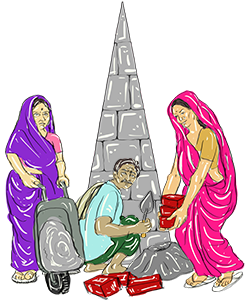
Collecting, distilling, and actioning local risk and resilience perspectives

Integral World is actively engaged in the pursuit of SDGs to promote sustainable prosperity. We firmly believe in fostering economic growth that is inclusive, environmentally responsible, and advantageous for all. Through our support for entrepreneurship, fair trade, and responsible consumption, we aim to create opportunities that enable individuals and communities to prosper, while simultaneously safeguarding natural resources and reducing inequality.
To achieve prosperity, Integral World focuses on supporting sustainable economic growth and entrepreneurship. We offer comprehensive business development services, mentorship programs, and access to finance specifically designed for small and medium-sized enterprises. By advocating for fair trade, responsible consumption, and inclusive markets, we actively contribute to poverty reduction, job creation, and economic empowerment, ensuring that prosperity is shared equitably among all.
Integral World recognizes that fostering prosperity requires supporting sustainable economic development and entrepreneurship. We provide training, mentorship, and access to resources for individuals and businesses, with a particular emphasis on underprivileged areas. Our commitment to promoting fair trade, responsible business practices, and innovative solutions drives socially inclusive and environmentally sustainable economic growth. Through our initiatives, we aim to create opportunities for income generation, job creation, and economic empowerment, ultimately enhancing the living standards of communities.
Integral World’s commitment to promoting sustainable prosperity aligns with several SDGs, including SDG 6 (Clean Water and Sanitation), SDG 7 (Affordable and Clean Energy), SDG 8 (Decent Work and Economic Growth), SDG 9 (Industry, Innovation, and Infrastructure), and SDG 10 (Reduced Inequalities). Here’s an elaboration on how Integral World can contribute to each of these goals:
Integral World can support initiatives that promote access to clean water and sanitation facilities in underserved communities. By partnering with local organizations and governments, Integral World can help implement water and sanitation projects, improve water resource management, and raise awareness about the importance of clean water and proper sanitation practices.
Integral World can work towards promoting affordable and clean energy solutions. This can be achieved by supporting renewable energy projects, advocating for policies that promote energy efficiency, and fostering partnerships with renewable energy providers. By facilitating the adoption of clean energy sources, Integral World contributes to reducing greenhouse gas emissions and improving energy access in communities.
The Integral World can play a vital role in promoting decent work and sustainable economic growth. By supporting entrepreneurship, providing business development services, and facilitating access to finance, Integral World helps create job opportunities and encourages economic empowerment. Integral World also advocates for fair labor practices, promotes skills development, and fosters inclusive business environments that prioritize the well-being and rights of workers.
Integral World can contribute to SDG 9 by supporting the development and improvement of sustainable infrastructure, particularly in underprivileged areas. This includes investing in transportation, communication, and energy infrastructure, as well as promoting innovation and technology adoption. By enhancing infrastructure and fostering innovation, Integral World facilitates economic growth, connectivity, and sustainable development.
Integral World strives to reduce inequalities by promoting inclusive economic growth and advocating for policies that address social and economic disparities. By supporting marginalized communities, providing training and skills development programs, and fostering inclusive business practices, Integral World helps bridge the inequality gap and promotes social inclusion.
By virtue of exchange, one man’s prosperity is beneficial to all others.

We help establish and act towards maximising the positive impact

We encourage you to look at the conscious side of capitalism

We empower our representatives to transform the system for good

We endeavour to help establish longlasting legacy

We enable you to root extensively and nourish all

Strategise
We are adept at aligning with your thoughts

Outreach
We can lead you in the right direction to rightful space

Action
We strive to steer you on a
steady course